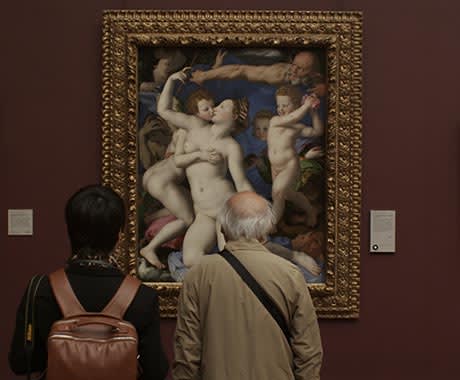Frederick Wiseman's particular approach to the documentary form is an acquired taste. Unlike most of his peers, who organize their work like a school essay detailing points to prove a thesis, Wiseman uses observed moments to deconstruct and assess a situation, building an impression and a story out of astute juxtaposition and the natural momentum of seemingly anodyne situations. He constructs an unfussy portrait of a working institution, taking us from the forefront of public perspective to the meeting rooms behind the scenes where decisions are made and debates are had.
National Gallery is no exception to this formula. Clocking in at three hours, it's actually one of his shorter films, detailing the many distinct subsections and considerations that comprise London's National Gallery, the famed art museum in Trafalgar Square that houses over 2,300 paintings ranging from the 13th to 20th centuries. From guided tours to retouching rooms to seminars and discussions with conservators (Larry Keith, in particular), we're immersed in this world, catching conversations and presentations that range from the spatial peculiarities of Vermeer to how detrimental the nature of conservation is.
Due to the very nature of what the gallery is — and the fact that, as an institution, it's governed and managed by people that research and speak for a living — there's a sense that we're only capturing people at their best. Whereas previous works from Wiseman that examined The National Ballet in France or the University of California at Berkeley had a decidedly argumentative and animated dynamic amidst the various, often-conflicting factions, the National Gallery feels more rehearsed and collaborative. It's mostly because the historians and theorists and conservators on display have perfected their speeches and have been published on the topics they raise many times over. As such, there's more of an informative sensibility about National Gallery than there is an investigative and revealing one.
Another factor is Wiseman's presumed preoccupation with the nature of art conservation and the effect technology has had on restoration and knowledge of art history. The lack of commerce and limited discussion about the nature of marketing, advertising and consumer enterprise hinders the usually comprehensive vision that Wiseman demonstrates in his work. It's possible his access to such tète-a-tètes were limited here, but it seems more likely that his personal interests lie specifically in learning more about how a canvas can be explored to learn subtle details about its original creation. The result is a documentary that feels less comprehensive and immersive than Wiseman usually presents.
Still, his vision is, for all intents and purposes, a distinct and sober look at what working at the gallery is like. It never caters to the demands of the dramatic form, instead existing as an observed document of a specific space and time.
(Zipporah)National Gallery is no exception to this formula. Clocking in at three hours, it's actually one of his shorter films, detailing the many distinct subsections and considerations that comprise London's National Gallery, the famed art museum in Trafalgar Square that houses over 2,300 paintings ranging from the 13th to 20th centuries. From guided tours to retouching rooms to seminars and discussions with conservators (Larry Keith, in particular), we're immersed in this world, catching conversations and presentations that range from the spatial peculiarities of Vermeer to how detrimental the nature of conservation is.
Due to the very nature of what the gallery is — and the fact that, as an institution, it's governed and managed by people that research and speak for a living — there's a sense that we're only capturing people at their best. Whereas previous works from Wiseman that examined The National Ballet in France or the University of California at Berkeley had a decidedly argumentative and animated dynamic amidst the various, often-conflicting factions, the National Gallery feels more rehearsed and collaborative. It's mostly because the historians and theorists and conservators on display have perfected their speeches and have been published on the topics they raise many times over. As such, there's more of an informative sensibility about National Gallery than there is an investigative and revealing one.
Another factor is Wiseman's presumed preoccupation with the nature of art conservation and the effect technology has had on restoration and knowledge of art history. The lack of commerce and limited discussion about the nature of marketing, advertising and consumer enterprise hinders the usually comprehensive vision that Wiseman demonstrates in his work. It's possible his access to such tète-a-tètes were limited here, but it seems more likely that his personal interests lie specifically in learning more about how a canvas can be explored to learn subtle details about its original creation. The result is a documentary that feels less comprehensive and immersive than Wiseman usually presents.
Still, his vision is, for all intents and purposes, a distinct and sober look at what working at the gallery is like. It never caters to the demands of the dramatic form, instead existing as an observed document of a specific space and time.
